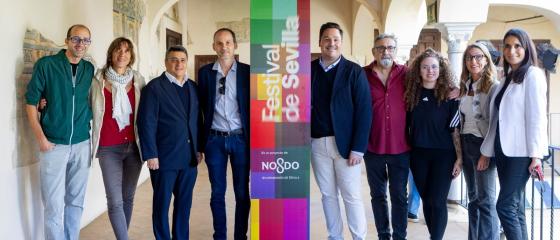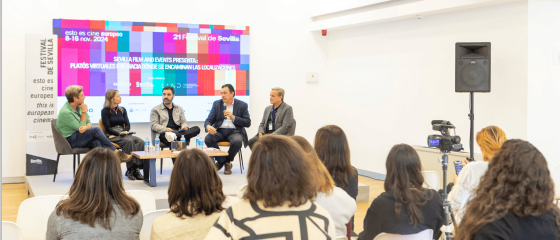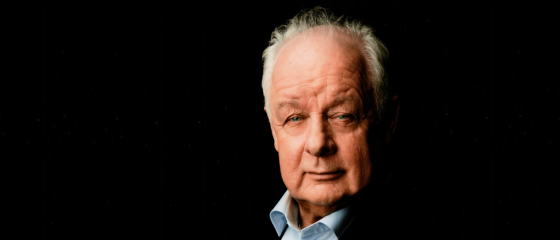The Seville European Film Festival brings to Spain the first outcome of the visionary/mad project, which for more than 10 years turned a giant set into the USSR of the 1950s. DAU. Natasha is one of the highlights of the Official Section.
The SEFF in its 17th edition, couldn't miss the opportunity to show the first results from one of the craziest, most eccentric and visionary ideas in the history of cinema. If it could be compared, (but it can't) it would be compared to the avant-garde Dogma'95. But DAU is something else, much more monumental and wild: everything comes from the wonderful mind of the Russian Ilya Khrzhanovskiy (Moscow, 1975), whose idea was to reconstruct Stalin's USSR in an enormous set, which would be known as The Institute. As if it were a sociological experiment, he took with him more than 400 people willing to travel through time without riding a flashy DeLorean: so, professionals from different fields had to dress, talk, breathe, 24 hours a day as if they were in the 50's and 60's. Khrzhanovskiy's desire was to turn the Institute into a creative laboratory, but the project also had a lot of historical research and anthropological study. Like if The Truman Show would speak Russian.
To better understand the magnitude of the work behind DAU. Natasha, and the other fifteen feature films and the various series that resulted from the temporary confinement, we give you five keys to understand what lies behind an unprecedented initiative.
1) The Institute
Ilya Khrzhanovskiy's initial idea was to make a feature film, but DAU soon grew into a unique, multidisciplinary and constantly evolving project that combined film and science, anthropology and spirituality, art and experimentation. In September 2009, the interior of the immense set was built, 12 thousand square meters located in the Ukrainian city of Kharkov, the largest ever built in Europe. Inspired by the Institute of Physical Problems of the Russian Academy of Sciences, a scientific research center headed by the Nobel Prize winner in physics Lev Landau, the Institute created by Khrzhanovsky opened the door to professionals of cinema, but also to scientists and workers of other sectors (from waiters to hairdressers or policemen), who were sent to the past: their commitment to the project included living months, years, in a microcosm reproducing the same living conditions of the USSR in the 50s and 60s, without the technological benefits of today. The line of cinematographic creation would end up growing and developing in other sectors and contexts.
2) Secrecy
For a decade, no one spoke publicly about what was happening inside The Institute. Among the rules accepted when entering its walls was to not talk about DAU. As was the case with The Fight Club. Very different social groups with totally different views on life lived just as their grandparents had done in Stalin's USSR, worked, dressed, loved, hated each other, and, of course, exposed. While conflicts, joys and tragedies were awakening, different stories were emerging that would be interminably filmed by the cameras. There was no script: "There was no prior written text. Everything was happening on the scene. Whoever was on it proceeded, acted, as dictated by their intuition or purpose," said Ilya Khrzhanovskiy at the presentation of DAU. Natasha at the Berlin Film Festival, where the first film of the mastodon project was released.
3) Experience or exploitation?
When the unusual aspects of the DAU Project were known, and rumors began to circulate about what was happening at the Institute, with open complaints from some of the participants, the criticism came, as it could not be otherwise. Khrzhanovskiy argued: "Those who participated in DAU are heroes, because they invested their time, work and emotions in a common creative project. There was no exploitation, we didn't do a Big Brother show. The participants consciously prepared for the experience. And when they started shooting, there were certain rules that they were aware they had to follow. It was not a constant shooting, with the idea of accumulating hours of footage in order to later shape it. Each filming had a meaning, a purpose, and there were long periods when the cameras were turned off. The participants were aware of when it was being filmed, they were not obliged to participate in all the recording processes, hidden cameras were not used, and the filming team was also dressed in period costumes.
4) Results
Created with the intention of interweaving fiction and reality and giving free rein to creativity, the ambitious multidisciplinary experiment has resulted in more than 700 hours of footage spread over fifteen films and several series. Ilya Khrzhanovsky was assisted by other filmmakers, including Jekaterina Oertel, Ilya Permyakov and Aleksey Slusarchuk. It is worth mentioning that the mentor of the project came to DAU after attracting attention with his first feature film, 4 (2004), with which he won awards at the festivals of Rotterdam, Buenos Aires, Sochi or Athens, and was nominated for the European Film Awards.
5) Natasha
DAU. Natasha is the first offspring of the project. Co-directed by Khrzhanovsky and Jekaterina Oertel, it was presented at the Berlinale (which also screened, out of competition: DAU. Degeneratsiya), where it won a Silver Bear for Artistic Contribution, now arriving in Spain thanks to the SEFF. The protagonist, who gives her name to the film (and who appears in other films of the initiative), works in the canteen of a scientific research center where the action (of this and other films of the DAU universe) takes place. Placing the focus on the power relations under Stalinist terror. Using non-professional actors, the film includes though scenes featuring sex and torture which had led to its censorship in Russia, claiming to be "spreading pornography and propaganda". In any case, this is a perfect opportunity to penetrate into a world without references, unique, and the kind of film that keeps us believing in cinema as magic, reminding us that not everything has been invented.







